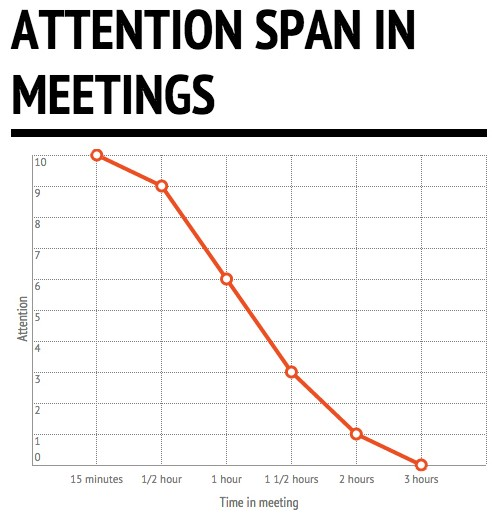Introduction
In today’s dynamic work environment, “meeting inefficiencies” are a significant productivity bottleneck, with an overwhelming influx of “too many meetings” exacerbating the issue.
Since February 2020, the frequency of meetings has surged by a remarkable 192%, leading to numerous challenges. A staggering 58% find virtual meetings unfavorable for brainstorming, while 57% need help to catch up if they join late. A shift towards “fewer meetings” with a robust “meeting agenda” is imperative to enhance productivity and efficacy. Such a structured approach aims to alleviate the common issues experienced by “meeting participants,” such as unclear “next steps” and difficulties summarizing meetings.
Since many professionals spend most of their week in meetings, it is essential to transform meetings into strategic platforms for skill enhancement and innovation, especially with the growth of AI.
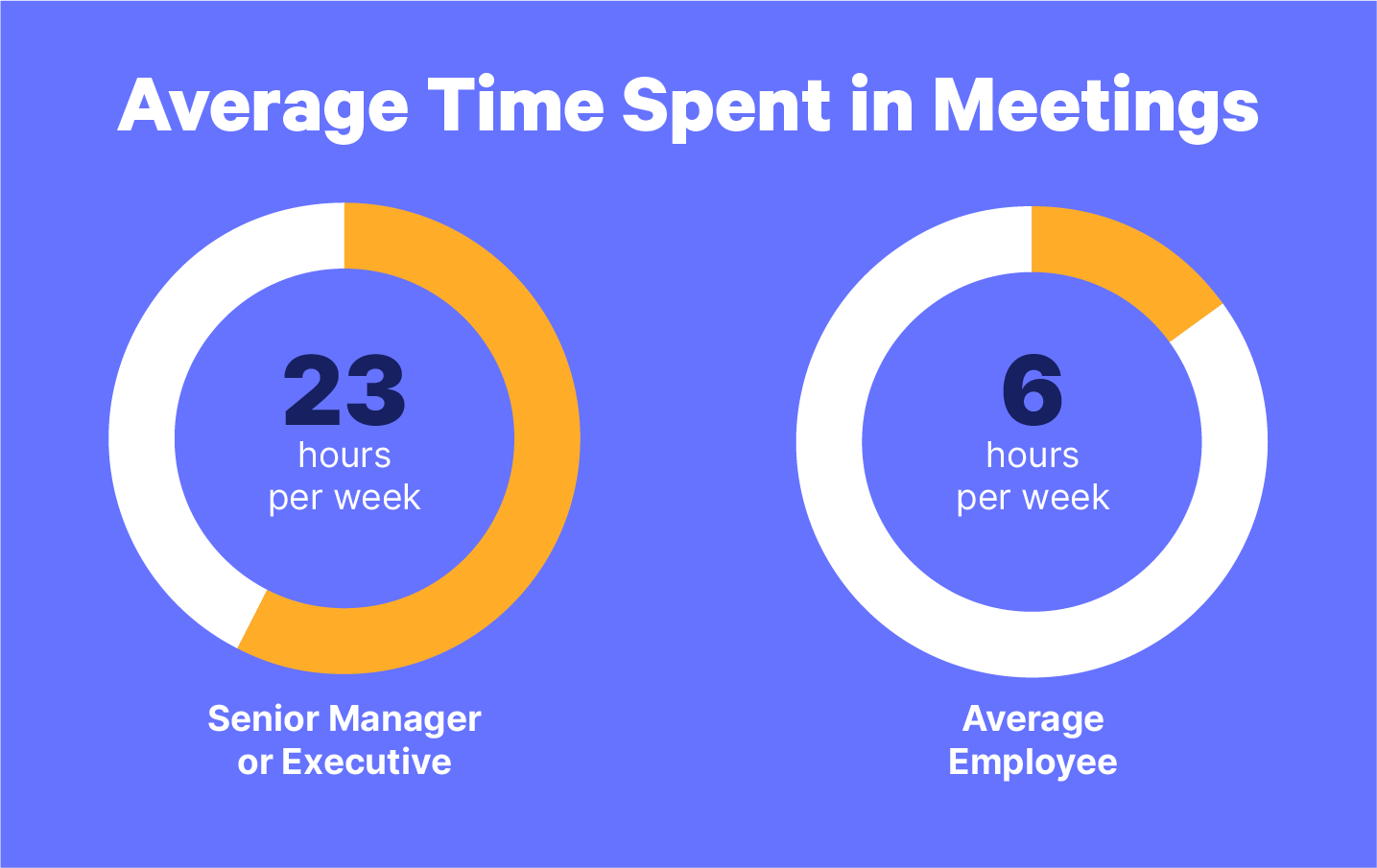
I’d like you to look at this article to explore actionable strategies to revitalize meeting structures, fostering an environment of clarity, purpose, and adaptive growth in the face of technological advancements.
The Anatomy of Inefficient Meetings
As many organizations grapple with optimizing their number of meetings, there’s a pressing need to understand the core issues underpinning inefficient meetings.
The “meeting problem” is more than just an organizational science issue; it carries a significant cultural tax, impacting not just direct costs but also the broader elements of personal interaction, personal time, and employment stability.
Meetings, ideally facilitating collaboration and decision-making, often become burdensome due to several factors.
Let’s dive deeper:
Duration:
- Limit the length of meetings to maintain energy and focus.
- Ensure meetings respect both the organization’s and participants’ time (remove friction, start with to the point – Bottom Line Up First).

Focus and Relevance:
- Meetings must have a clear, predefined objective to maximize personal interaction (define it, write it, share it inside the invite).
- Foster discussions that remain pertinent to the meeting’s core objectives (avoid running far away from the core)
- Employ strategies like the ‘Parking Lot’ method to prioritize relevant discussions, offering better meetings that value everyone’s time.
Participant Roles and Autocratic Decision Making:
- Clearly define each participant’s role to prevent autocratic decision-making and ensure inclusive engagement.
- Fewer opportunities for active participation can lead to meeting inefficiencies (respect “raise hand” culture when online meetings, ask people who break into the conversation to raise a hand)
Direct Costs and Cultural Tax:
- Beyond the direct costs of prolonged and irrelevant meetings, a cultural tax affects the morale and productivity of teams.
- Strive for “meeting-free” days or periods, providing employees with respite and time for focused work.
In today’s fast-paced work environment, many organizations are realizing the importance of better meetings. By addressing these elements, we can ensure more productive meetings and foster an environment that values personal interaction, minimizes the cultural tax, and champions employment stability.
Envisioning AI-Driven Meetings
In the evolving landscape of corporate operations, integrating various AI tools can revolutionize how meetings are conducted. The graph below highlights the elements that contribute to a successful meeting. AI can help address these key elements.

Envision a scenario where an efficient meeting organizer, powered by artificial intelligence, schedules and categorizes meetings based on their objectives.
- Be it a decision meeting,
- discussion meeting,
- or an information-sharing session.
For instance, a decision meeting, typically attended by 6 to 8 decision-makers, can be enhanced with AI tools that provide structured agendas, identifying critical decisions and ensuring more autocratic decision-making.
This reduces the chances of unproductive meetings and optimizes time spent.
In contrast, larger discussion meetings, designed for active dialogue between 8 to 20 attendees, can benefit from AI-driven facilitation tools that encourage personal interaction and make meetings more effective.
The dreaded bad meetings, often characterized by a lack of clarity and purpose, can be minimized as AI tools ensure agendas clarify topics in advance, particularly in vast information-sharing meetings with up to 2,000+ attendees.
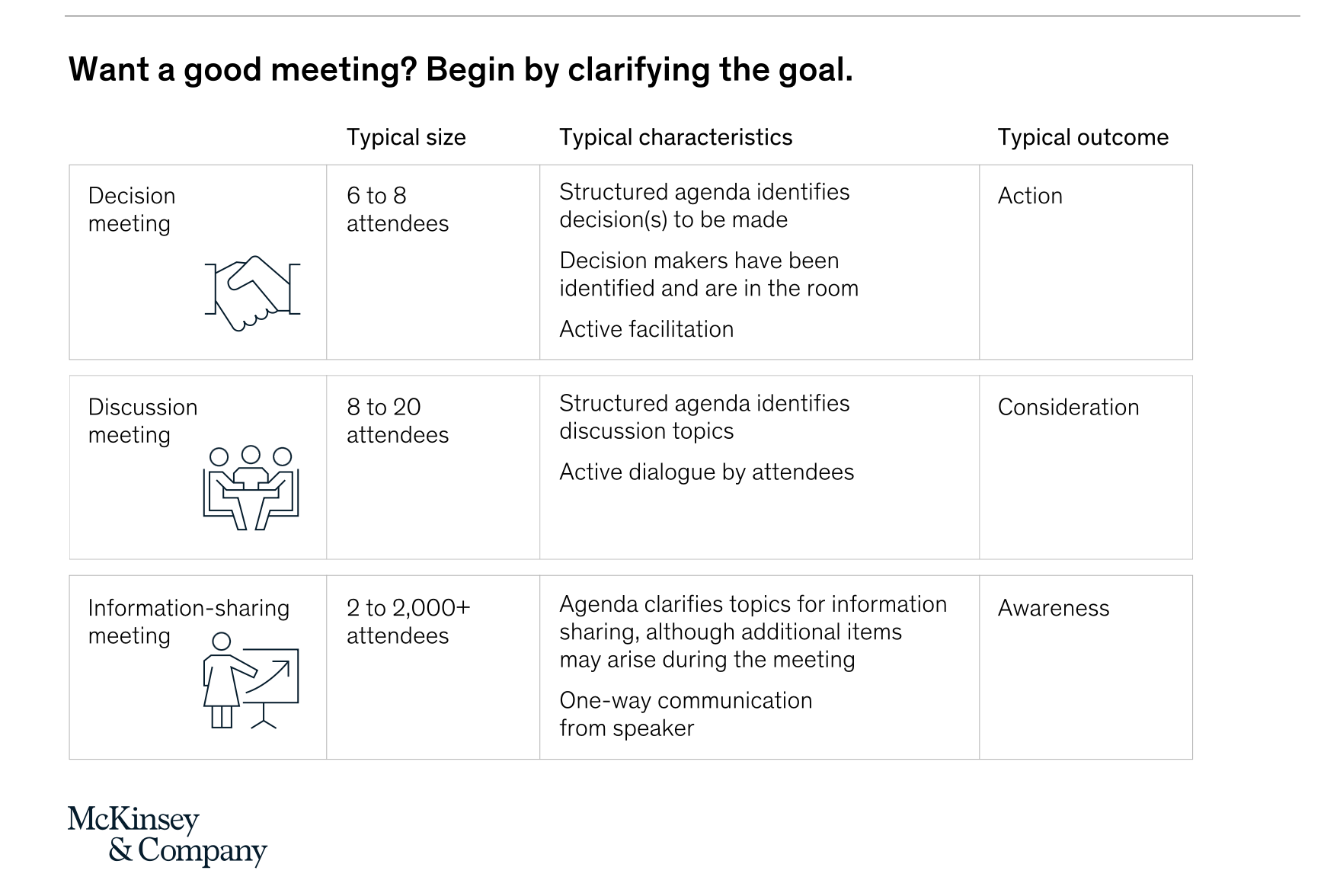
As a follow-up, AI can analyze meeting outcomes, suggest actionable items, and even schedule more meetings or follow-up sessions based on feedback.
I believe the future of successful meetings lies in integrating AI, ensuring individuals can focus on discussions while AI manages the logistics, making the most of everyone’s time.
AI in Scheduling and Planning
In recent years, AI-driven scheduling and planning tools have transformed how organizations operate. Companies are leveraging these tools to ensure alignment among team members, requiring less input from users while maximizing output.
- Reclaim stands out as a tool best suited for protecting your habits. It excels in managing recurring events and offers a free plan for up to 2 calendars, three patterns, and limited integrations, with paid plans starting at $8/user/month.
- Clockwise is another leading tool, ideal for syncing team calendars. The platform’s thorough onboarding experience ensures attendees are well-prepared for their engagements. Its free plan covers basic features, while paid plans are $6.75/user/month.
- Motion specializes in AI-assisted project management and emphasizes high visibility for tasks, costing $34/month for individuals and $20/user/month for teams.
- Clara replicates the experience of a human-like AI virtual assistant with remarkable flexibility, truly mirroring a human assistant’s responsiveness. Its plans begin at $99/month. For those seeking simplicity,
- Trevor offers an intuitive, free AI solution for task management, with a paid plan available at $3.99/month.
- Kronologic is tailored for following up with more leads, especially for sales teams. It can even replace tools like Calendly, with plans starting at $6/month. Lastly,
- Scheduler AI is perfect for managing meetings for busy teams, ensuring that organizations can efficiently attend all meetings. Its pricing starts at $25/user/month.
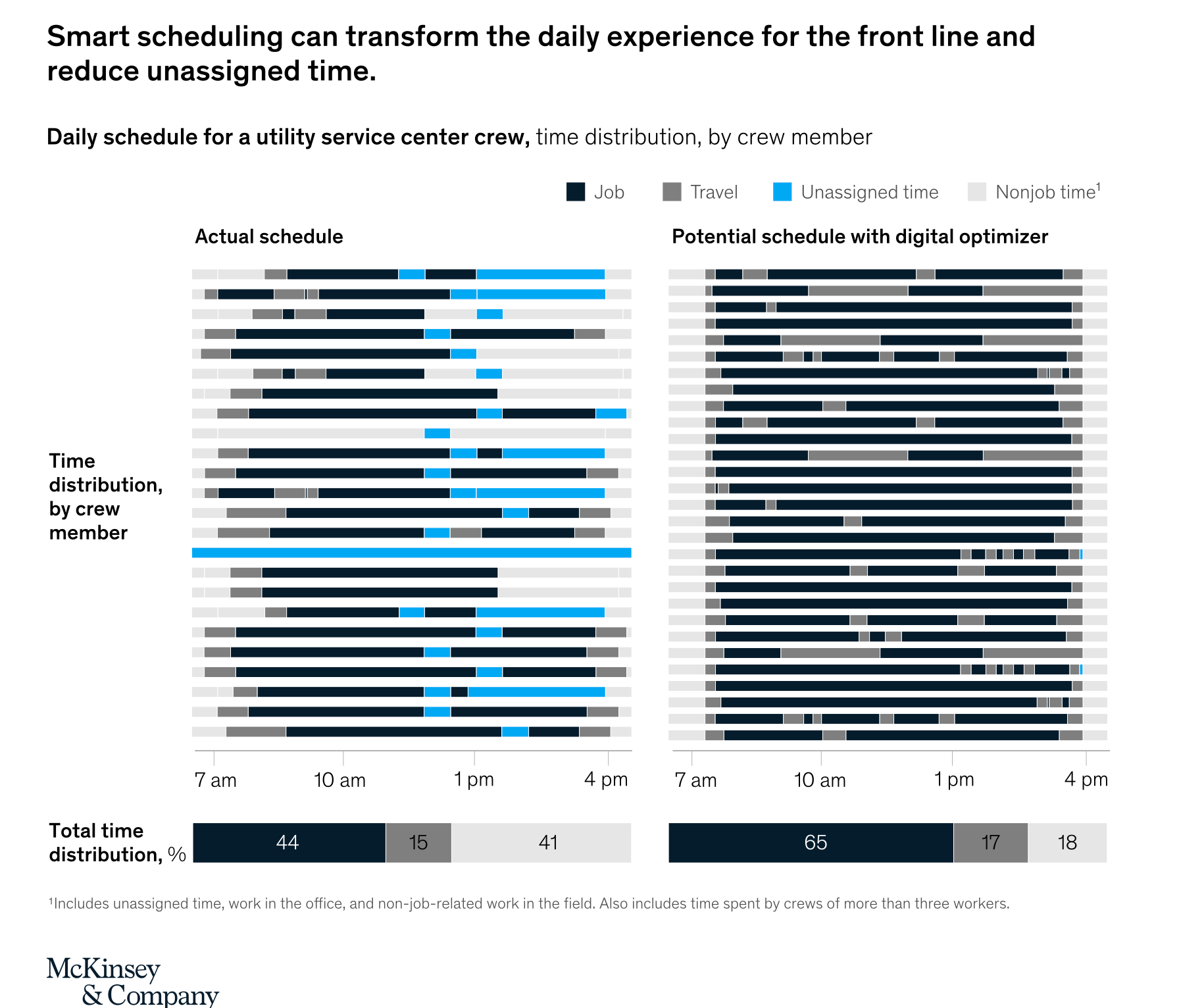
These tools are not only reshaping how companies schedule and plan but also redefining efficiency in the modern workspace.
AI in Meeting Facilitation
But AI’s capabilities don’t just stop at planning. During the meeting, AI can play an active role in ensuring things run smoothly. Imagine a system that actively listens to the discussion, making real-time suggestions based on the agenda (read.ai can do it).
If participants stray off-topic, the AI can gently remind them to return to the main points, ensuring that time is not wasted on tangential discussions. Moreover, for larger meetings where not all attendees might get a chance to voice their opinions, AI can analyze speech patterns and participation rates, prompting the moderator to invite quieter members to share their insights, fostering inclusivity.
Meeting Facilitation Rules that are useful and which can be AI-supported easily:
- Clear Objectives: Every meeting should have a clear purpose and desired outcomes (schedulers, see section above)
- Agenda Distribution: Share the meeting agenda in advance so participants can prepare (schedulers, see section above)
- Timely Start and End: Respect participants’ time by starting and ending meetings as scheduled (Toggle Track or any Pomodoro-type software)
- Active Participation: Encourage all attendees to participate and share their thoughts (read.ai, otter.ai, and similar, including jamboard)
- Stay on Topic: Stick to the agenda and avoid straying into unrelated topics (miro or similar)
- Limit Distractions: Ask participants to mute themselves when not speaking and avoid multitasking (auto muting option or auto gestures inside zoom, Google Meet)
- Assign a Facilitator: A designated person to guide the meeting ensures it stays on track.
- Capture Action Items: Document decisions made, tasks assigned, and deadlines set during the meeting.
- Encourage Respect: Ensure everyone’s opinions are respected and no one is talked over or interrupted.
- Follow-Up: After the meeting, distribute minutes or a summary, and ensure that action items are tracked and executed (see next section)
AI in Follow-ups and Accountability
Post-meeting, the benefits of AI continue. Automated systems can generate minutes, highlighting critical decisions, action items, and owners, reducing manual effort and ensuring nothing slips through the cracks.
As an example, think of a project review meeting. Instead of manually jotting down every detail, attendees can focus on the discussion, knowing that an AI is capturing everything, ready to produce a concise summary at the end; here is an example.
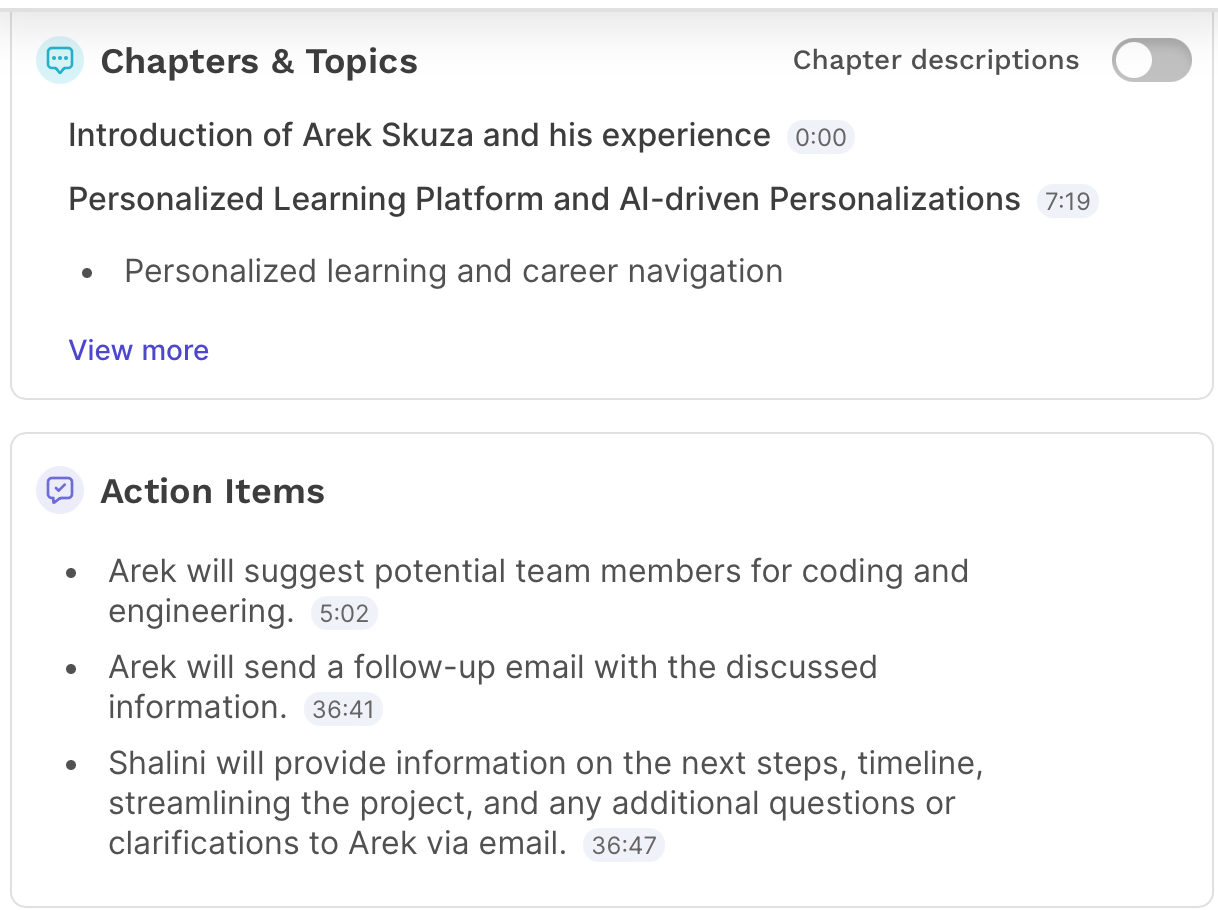
Utilizing AI can significantly streamline post-meeting activities. The screenshot reveals structured chapter topics and action items from a meeting.
- AI can automatically transcribe the discussion, categorizing key sections into distinct topics. This not only aids in quick referencing but also highlights significant discussion points. More crucially, the action items section captures tasks assigned to participants, ensuring accountability.
- AI can automatically generate these tasks, assign deadlines based on the content, and sync them to participants’ calendars or task management tools.
- Furthermore, the system can send follow-up reminders, ensuring timely execution. By automating these processes, AI ensures efficient post-meeting management, reducing manual oversight and enhancing productivity.
Ethical and Privacy Considerations
Incorporating AI into the meeting landscape undoubtedly elevates efficiency and productivity. However, it’s imperative to navigate the ethical and privacy considerations intrinsic to AI implementations diligently.
AI tools actively participating in meetings will have access to sensitive discussions and information. Thus, robust measures should be implemented to safeguard data integrity and confidentiality. Ethical considerations also extend to ensuring AI applications are unbiased and inclusive, promoting a diverse and respectful meeting environment.
Additionally, transparency is vital; participants should be fully informed about the AI tools utilized, the data being captured, and its subsequent applications. A transparent approach fosters trust and ensures that the use of AI is aligned with organizational values and legal standards.
Meeting organizers should also prioritize obtaining consent and ensuring participants are comfortable with AI’s role within the meeting. An ethically designed AI-driven meeting environment, mindful of privacy and user consent, not only fortifies the meeting’s integrity but also augments participants’ confidence and willingness to engage effectively, thereby enriching the overall meeting quality and output.
Rules when using AI for meetings:
- Always ask participants for permission to use tools like read.ai to join a call. Ensure that all attendees are informed and have consented to the presence and use of AI tools like read.ai within the meeting. Full disclosure promotes a trustworthy and respectful environment.
- Ask participants if they are okay with recording the meeting: Before recording, seek explicit consent from each participant, clarifying the purpose and duration of the recording’s storage and accessibility.
- Offer participants notes and follow-ups and deliver what you promise: Commit to providing attendees with comprehensive and accurate meeting summaries, action items, or other follow-up materials as promised, ensuring accountability and reliability.
- Ensure secure storage and limited access to meeting data: Store recorded meetings, transcripts, and other generated data securely, allowing access only to authorized individuals to maintain confidentiality and prevent unauthorized use.
- Implement data retention policies: Establish and communicate clear guidelines regarding the duration for which meeting data will be stored and ensure its secure disposal after the retention period to safeguard sensitive information.
- Maintain transparency regarding data usage: Communicate how the data collected during meetings, whether through recordings, transcripts, or AI tools, will be utilized, ensuring alignment with participants’ expectations and organizational policies.
Embracing the Future: Steps to Transition
- Innovate Meeting Structures: Companies should innovate and evolve their current meeting structures, making them more dynamic, focused, and objective-driven, aligning with technological advancements such as AI. Start small, take off-the-shelf products, and embed them into your process (examples are in the sections above)
- Facilitate Intelligent Conversations: Foster environments that encourage intelligent and productive conversations. Utilize AI to enhance the quality of discussions, ensuring that they are focused, relevant, and conducive to decision-making and problem-solving (record, transcribe, auto-followup)
- Empower Teams: Empower teams by integrating advanced tools that facilitate better planning, scheduling, and follow-ups, ensuring that meetings are more organized, purposeful, and result-oriented (give people constant training)
- Enhance Collaboration: Facilitate better collaboration within teams through the use of AI, ensuring that meetings are not just about discussions but also about collective problem-solving and decision-making (use jamboard, miro, notion.ai)
- Encourage Adaptive Growth: Encourage an organizational culture that is adaptable and ready for continuous growth and improvement, ensuring that teams are always equipped and prepared to embrace new changes and challenges.
- Implement Actionable Strategies: Focus on implementing actionable strategies (tools and mindset change) that can help improve the efficiency and productivity of meetings, ensuring that they are always aligned with organizational goals and objectives.
- Promote Strategic Planning: Promote strategic planning in meetings, ensuring that every meeting has a clear purpose, agenda, and objectives, making them more focused and result-driven. Say no to meetings without agenda and clear goal, and where all is manual instead of at least semi-automatic)
Conclusion: The Transformative Potential of AI in Meetings
Meetings have become a significant productivity bottleneck, often mired in issues related to duration, focus, participant roles, and direct costs. As organizations grapple with these problems, the advent of AI offers a beacon of hope for transforming meetings into efficient, purpose-driven platforms.
In many organizations, AI can play a pivotal role in meeting organization, scheduling, and facilitation. AI-driven meetings promise structured, goal-oriented discussions, thus mitigating the woes of unproductive gatherings. By categorizing meetings based on their objectives and streamlining processes, AI optimizes time and resources, ensuring that participants can focus on meaningful conversations and decision-making.
AI’s impact extends beyond scheduling and organization. During meetings, AI can actively contribute to maintaining focus and relevance. It can gently steer discussions back to the core agenda, fostering inclusivity and ensuring that quieter voices are heard, promoting a more productive and respectful atmosphere.
Ethical considerations are paramount when integrating AI into meetings. Ensuring transparency, data security, and user consent are fundamental to maintaining trust and respecting privacy. Participants should always be informed about the presence and use of AI tools and recordings, while organizations must implement strict data access and retention policies.
Overall, AI presents a transformative solution to the age-old problems of meetings, making them more meaningful, efficient, and adaptive to the evolving technological landscape. As organizations continue to adopt AI, meetings can evolve into a space where creativity, innovation, and productivity thrive. By harnessing the potential of AI, the future of meetings is brighter and more purpose-driven.
References:
- Will AI fix work, May 9, 2023, Microsoft
- Want a better decision? Plan a better meeting, May 8, 2019, McKinsey
- The 7 best AI scheduling assistants in 2023, August 1, 2023, Zapier
- Smart scheduling: How to solve workforce-planning challenges with AI, McKinsey
- The joy of timeboxed meetings, Boost
- What do professionals think are the key elements to a successful meeting?, 2019, Doodle
- Average Time Spent in Meetings, September 9, 2022, Embroker


